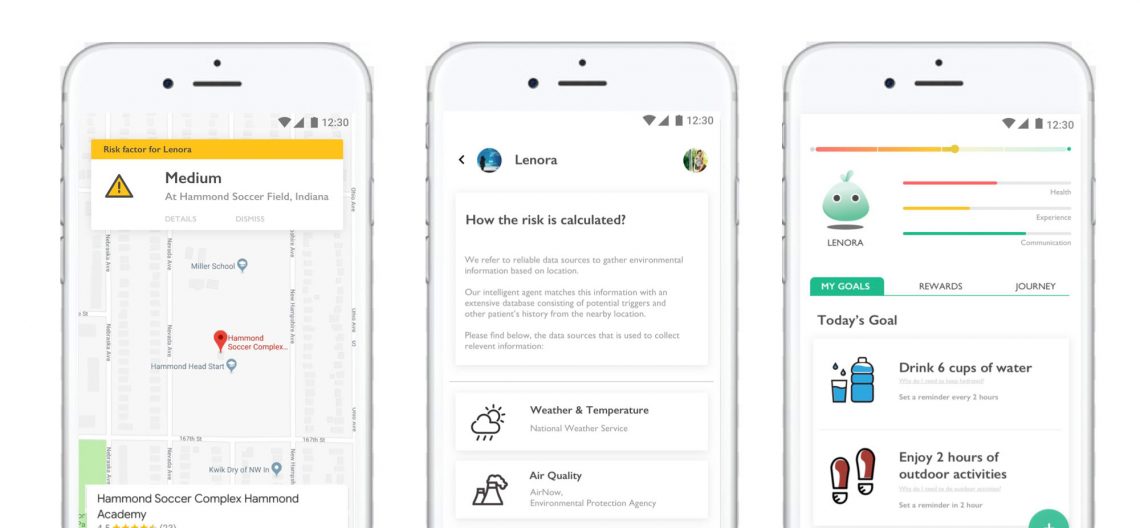
Collaborating for a solution
My journey into this problem area began five years ago when ID assembled a team of student research assistants to work on a government-funded research project under the auspices of the Chicago Trial Consortium, which is comprised of six clinical centers, four collaborating partners, three consultants, and a community healthcare worker coordinating center. The project was named the CHICAGO Plan (Coordinated Healthcare Interventions for Childhood Asthma Gaps in Outcomes).
Funded by the Patient-Centered Outcomes Research Institute (PCORI), our multicenter comparative effectiveness trial tested strategies to improve the care and outcomes of African–American and Latino children with uncontrolled asthma presenting to the emergency department (ED) in Chicago.
Introducing CAPE, a tool for caregivers
From our field research findings, my colleague Kim Erwin (MDes 1993) conducted additional research that led to the design of a paper-based communication tool that would help healthcare staff and caregivers more effectively record, track, and preserve information at the time of a child’s discharge from the emergency department. This tool was called the CAPE (CHICAGO Action Plan after ED discharge) and a description of the tool, its underlying theory, and application was published in the Journal of Comparative Effectiveness Research2. It is one of the first design research papers published in a peer-reviewed medical journal. Since then, Kim has moved to the University of Illinois at Chicago to establish the Institute for Healthcare Delivery Design and continues to build a practice of using design methods to improve communication design in the healthcare context.
Digitizing CAPE = dCAPE
My team’s next exploration was to investigate building on the CAPE tool by transitioning its information to a smartphone app to improve availability and to include other information, such as an appointment calendar, map directions, and contact information, that is typically provided in our Internet-connected society. The result of this design iteration became known as the dCAPE or “digital CHICAGO Asthma Plan for Everyone” app. And, as you may guess by now, we are working on the third design iteration of that app (i.e., dCAPE 3.0).
Iterating and improving
In each iteration, we have learned lessons that have revealed the next set of research questions and opportunities for improvement. In dCAPE 1.0, we wanted to discover what information was essential, meaningful, and collectible in a smartphone context. In dCAPE 2.0, we wanted to design for supporting behavior change to guide the app users to more success through education and compliance with suggested protocols. And, for dCAPE 3.0, we wanted to design for simplicity and automaticity.
As a result, dCAPE 3.0 became our exploration into the technologies of artificial intelligence and intelligent agents. From reading classic AI literature3, our team learned that there were five kinds of intelligent agents and that each type of agent could be applied in certain contexts. In our current design iteration, we focused on three types of agents: simple reflex, model-based reflex, and goal-based agents and we discovered that they all have unique roles and advantages depending on the type of data available, the situation of the caregiver and patient, and the surrounding environment.
Join us as we share our story on February 21 at the Institute of Design located in the new Kaplan Institute on Illinois Tech’s main campus.
References
- Gupta R, Zhang X, Sharp L, Shannon J, Weiss K. “Geographic variability in childhood asthma prevalence” in Chicago. Journal of Allergy and Clinical Immunology. 2008, 121(3): 639–645.
- Erwin, Kim, “Engaging stakeholders to design a comparative effectiveness trial in children with uncontrolled asthma,” in Journal of Comparative Effectiveness Research, 2016, 5(1), pp. 17-30.
- Norvig, Peter and Russell, Stuart, Artificial Intelligence: A Modern Approach, 2003, 2nd Ed. Prentice Hall, Pearson Education Inc.